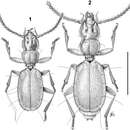Description
provided by Zookeys
Body small (ABL = mm 1.80 ♂ 2.19 ♀), elongate, rather flattened, anophthalmous. Pubescence very sparse, short, yellow, recumbent.
Head relatively large but narrower than pronotum (WH/WPm = 0.97 ♂, 0.95 ♀), clypeus truncate with the frontoclypeal sulcus distinct. Frontal furrows with posterior round foveae, occiput coarsely and densely punctate. Mandibles slender with a simple apex. Maxillae strongly prominent, penultimate segments of maxillary palpi longer than broad, bearing 4 setae, terminal palpomeres protracted, needle-shaped, with an apical tuft of sensillae (Figs 3-4). Labium (Figs 5-6) with a large median tooth, showing two small basal setae; mentum with a large, rounded, depressed fovea, latero-posteriorly surrounded by a ring of 10-12 setae. Antennae moniliform from the fourth antennomere onwards, long, markedly exceeding the humeral portion of the elytra when stretched backwards. Cephalic chaetotaxy as in the description of the genus.
Pronotum slightly convex, subcordiform (WPa/WPp = 1.42 ♂, 1.54 ♀), with the maximum width at the anterior third (WPm/LP = 1.09 ♂, 1.10 ♀). Anterior angles obtuse and broad. Lateral margin hardly sinuated before the posterior angles, which are rectangular and slightly projecting laterally. Punctures of the disc nearly equal to those of the occiput. Anterior sixth of their length with a pair of marginal setae; basal setae lacking. Scutellum subtriangular, pointed apically, with distinct transverse cells.
Elytra longer than their combined width (WE/LE = 0.62 ♂, 0.66 ♀), widest closely behind one half of their length. Humeral angles rounded but evident; lateral margins without a distinct marginal groove but with edges finely denticulate. Sculpture of elytradistinctly microreticulate consisting of wrinkled lines; striae missing; recurrent striola lacking, disc without discal setiferous punctures. Scutellar pore umbilicate and shifted from its normal position, placed near the front edge of the elytra. Umbilicate series as inFigs 1-2, consisting in 9 setiferous pores; the main umbilicate pores bearing a long seta (sensuGiachino and Vailati in press) are the 2nd, 6th and 9th ones. 5th and 6th pores make a geminate pair, 5th, 7th and 8th decidedly shifted on the disc; 5th pore shifted after the 6th one.
Protarsomeres not dilated in the male. Mesotibiae (Figs 7-8) distally expanded on outwards and fringed with dense bristles, inner angles with additional spurs. All the last tarsomeres of pro- meso- and metatibiae hyaline and with a peculiar shape: widened at the base and narrowed at the apex.
Aedeagus (Fig. 9) with median lobe stout and poorly arcuate; apex, in lateral view, stout, and irregularly sub-squared, slightly bent downwards. Basal bulb of the median lobe small, with the basal orifice greatly expanded dorsally, reaching about one thirdof the length of the median lobe, delimiting two subequal lateral lobes. Shape of left and right parameres similar to each other, long, strongly widened at the base, sharply restricted, elongated and strongly curved upwards in the apical third. One large and stout coaxial seta at the apex and a second one, frail, small, ventral, in a preapical position. Inner sac with a median copulatory sclerite, clew-shaped with two dorsolateral branches.
Female genitalia as in the description of the genus.
- license
- cc-by-3.0
- copyright
- Pier Mauro Giachino, Borislav Guéorguiev, Dante Vailati
- bibliographic citation
- Giachino P, Guéorguiev B, Vailati D (2011) A new remarkable subterranean beetle of the Rhodopes: Paralovricia gen. n. beroni sp. n. belonging to Lovriciina new subtribe (Coleoptera, Carabidae, Trechinae, Bembidiini) ZooKeys 117: 59–72
- author
- Pier Mauro Giachino
- author
- Borislav Guéorguiev
- author
- Dante Vailati

